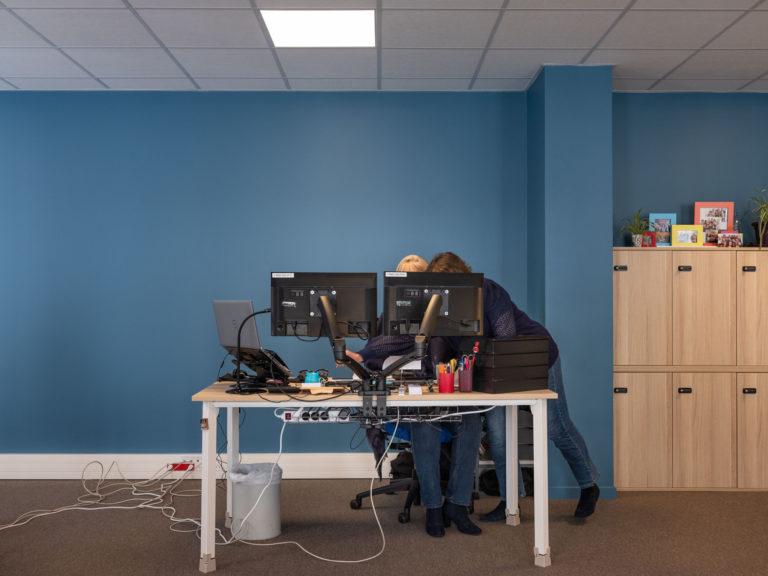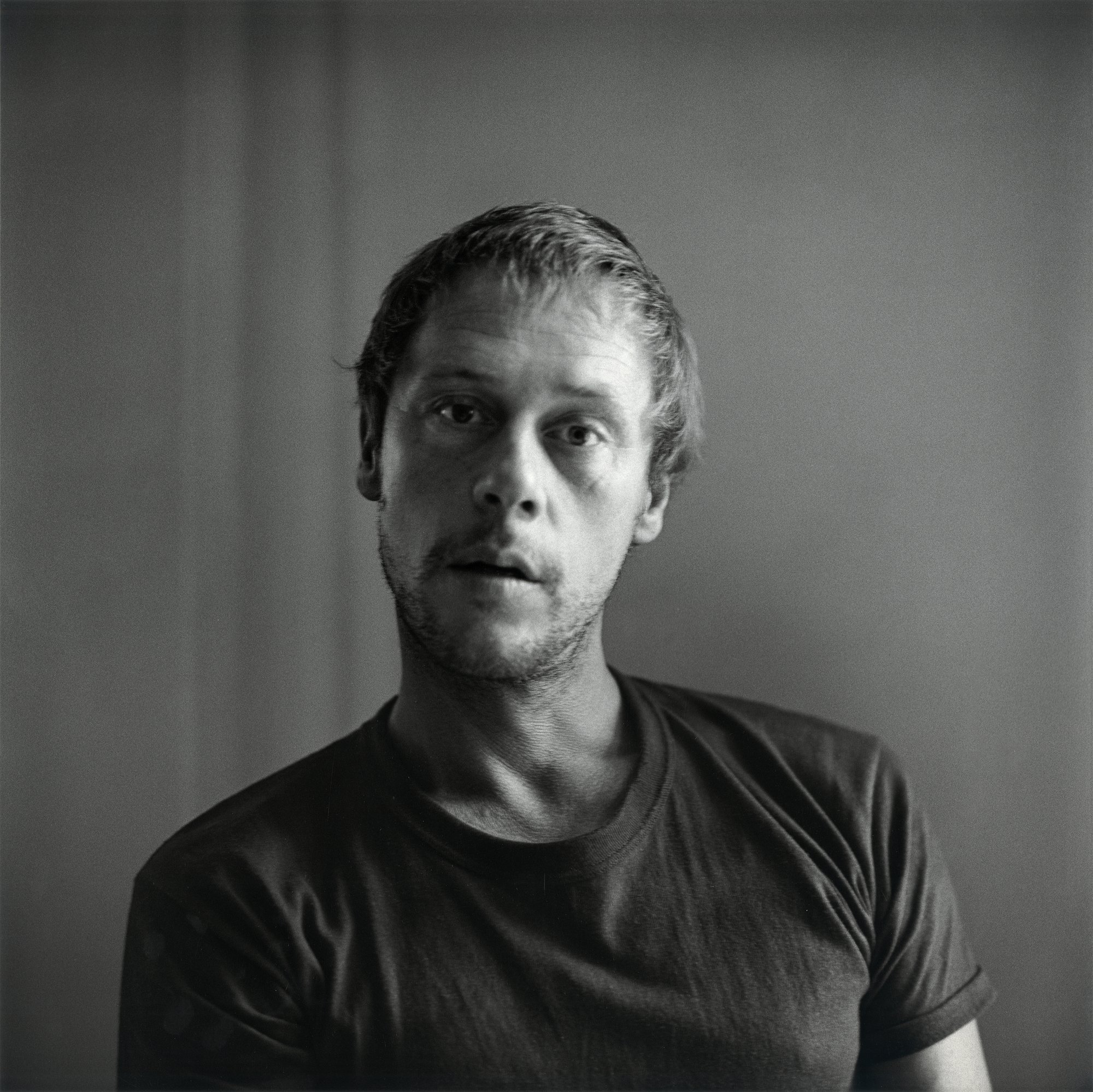Work No. 299
2003 - Photography (Photography)
75 x 100 cm
Martin Creed
This photograph of Martin Creed himself was used as the invitation card for a fundraising auction of works on paper at Christie’s South Kensington in support of Camden Arts Centre’s first year in a refurbished building in 2005. His broad smile, on the verge of laughter, encourages reciprocity on behalf of the onlooker. This could be said to be a typical tactic in Creed’s work as it is so infused with humor and irony. To him, art is like a game, or certainly very much a part of banal reality. Within the genre of self-portraits, this subverts the usual tradition of images of the artist as creator. Creed often jokes or questions whether the artwork (or in this case the persona of the artist) has any value or exists. Standing in front of a very British brick wall which likely carries art historical connections and puns, Creed seems to mock or certainly stand amazed at his own commercial success. In 2001, he won the Turner Prize with his controversial Work No. 227. The Lights Going on and off. “I want to make things. I’m not sure why, but I think it’s got something to do with other people. I think I want to try to communicate with other people, because I want to say ‘hullo’, because I want to express myself, and because I want to be loved”.
Martin Creed is a sculptor, filmmaker, performer and installation artist. Working within a minimal or conceptual mode, most of his artworks, objects, statements, suggestions or performances are titled “Work” and numbered. He wittily subverts the definitions of art and often uses mundane modest materials such as Blu-Tack, balloons, tape, piles of paper. In 1993, Work No. 81 consisted of a one-inch cube of masking tape in the middle of every wall in a London firm and since 1998 Work No. 200 proposes “the air in a given space” through filling it with balloons. Yet any anti-materialism is occasionally counteracted like in the marble staircase realized for the city of Edinburgh or the bronze sculptures. Creed is constantly reappraising things and nothings and all incumbent relations. During 5 months in 2008, Work No. 280 London runners sprinting one by one through the Duveen Galleries in Tate Britain. Martin Creed was born in Wakefield, UK, 1968. He lives and works in London, UK and Alicudi, Italy.
Colors:
Related works sharing similar palette

© » KADIST
Caroline Monnet, Mobilize A screening program followed by the artist in with conversation with Adam Piron, Assistant Curator for Film at LACMA Montreal-based artist Caroline Monnet explores Indigenous identity, bicultural living, and complex cultural histories through photography, sculpture, film, video, and installation...

© » KADIST
Frequencies of Tradition at Incheon Art Platform, Curated by Hyunjin Kim With works by Sooryeon Choe, Chung Seoyoung, Yoeri Guépin, Ho Tzu Nyen, Chia Wei Hsu, siren eun young jung, Jane Jin Kaisen, Alexander Keefe + Ashoke Chatterjee & Liz Phillips, Tomoko Kikuchi, Ayoung Kim, Gala Porras-Kim, Seulgi Lee, Young Min Moon, Hwayeon Nam, Part-time Suite, Ko Sakai & Ryusuke Hamaguchi, Lieko Shiga, Simon Soon + Roger Nelson & Stella, Stephanie Spray & Pacho Velez, Erika Tan, Fiona Tan, Evelyn Taocheong Wang, Wang Tuo, Ming Wong, Yo Daham, and Zheng Guogu Frequencies of Tradition departs from an understanding of tradition as a space of contestation, where one can critically reflect on Asian modernization and pluralize our comprehension of the regional modern...

© » ARTS EQUATOR
Cakap-Cakap: Interview with Charlinda Pereira and Rebekah Sangeetha Dorai for subTITLED 1.0 | ArtsEquator Thinking and Talking about Arts and Culture in Southeast Asia Articles February 16, 2021 ArtsEquator chats with producer and production stage manager, Charlinda Pereira and actress, Rebekah Sangeetha Dorai about their upcoming work subTITLED 1.0 by Bridging The Gap (BTG)...

© » EYE OF PHOTOGRAPHY
© 2023 All rights reserved - The Eye of Photography Olivier Culmann, URSSAF Normandie, site du Havre @ Olivier Culmann Le Havre, Seine-Maritime, Normandie, France 10/05/2023 © Olivier Culmann / Tendance Floue @ Thomas Jorion @ Sidonie Van Den @ Isabelle Scotta @ Carlo Lombardi S From October 21st to January 7th, 2024, for its 14th edition, 25 international photographers, both established and emerging, can be discovered in an open-air exhibition tour throughout the city, on the beach, and indoors at Point de Vue and Les Franciscaines...

© » KADIST
Jean-Luc Moulène
2004It rains, Paris, 1st July 2000 , which could be the refrain of a song, is the title of a photograph of a minimal moment, the vision of a Parisian pedestrian, a cut flower lying on the pavement covered in rain drops...

© » ARTS EQUATOR
Celebrating the monstrous other: "Anak Pontianak" and "Nobody" at LumiNation | ArtsEquator Thinking and Talking about Arts and Culture in Southeast Asia Articles Courtesy of The Filmic Eye August 5, 2019 By ila (1,100 words, 6-minute read) The year is 2049: two hundred years since the Pontianak first appeared in writing, marked insignificantly in Hikayat Abdullah as residues of superstitious and foolish beliefs of the Chinese and Malays that have persisted with time...

© » KADIST
Elina Brotherus
A subject’s back stands before a landscape of mountains, arid and majestic, Der Wanderer 3 revisits the theme of man versus nature dear to Romantic painting and the paintings of Caspar David Friedrich in particular...

© » HYPERALLERGIC
Archaeologists Find Evidence of Hallucinogenic Drug in Ancient Rome Skip to content A bust of Emperor Trajan surrounded by black henbane seends and flowers and a femur discovered by archaeologists (edit Valentina Di Liscia/ Hyperallergic ) Two new archaeological finds suggest Roman subjects at the northern edge of the ancient empire used a hallucinogenic and poisonous plant called black henbane, the effects of which were described by Greek philosopher Plutarch as “not so properly called drunkenness” but rather “alienation of mind or madness.” Dutch zooarchaeologists Maaike Groot and Martijn van Haasteren and archaeobotanist Laura I...

© » KADIST
Angelica Mesiti
2013Angelica Mesiti’s piece, The Calling (2013-14) is a poignant exploration of ancient human traditions evolving and adapting to the modern world...

© » KADIST
Arash Fayez
2021The short film I Can Only Dance to One Song by Arash Fayez features a series of people from the migrant community in Barcelona singing along or dancing to songs of their choosing...










